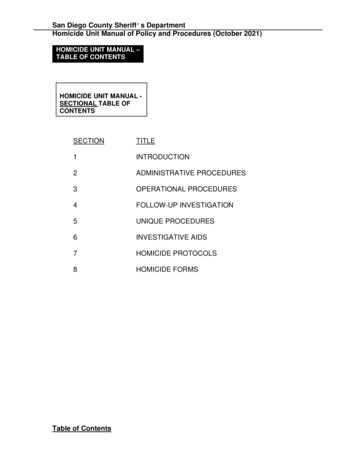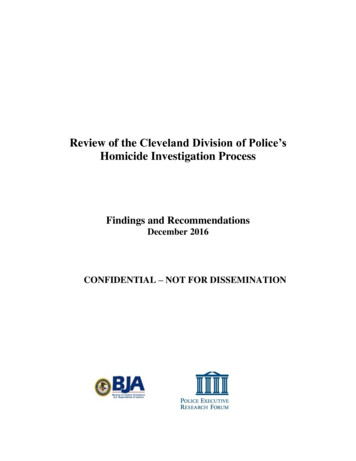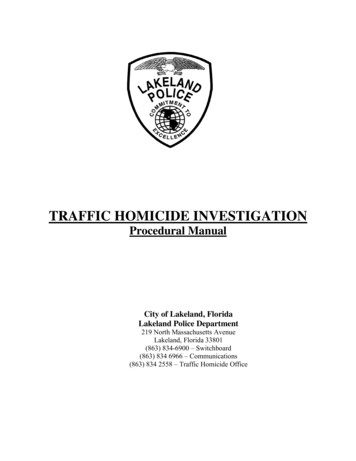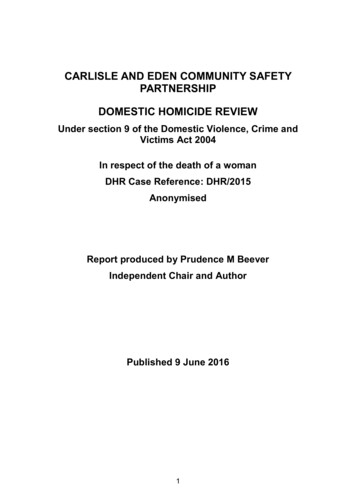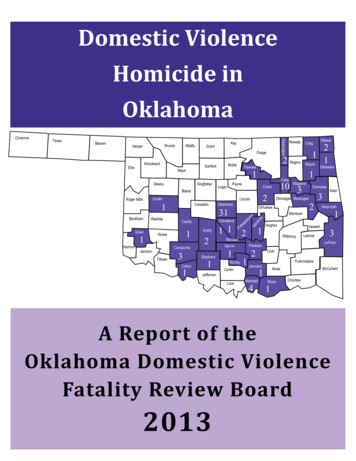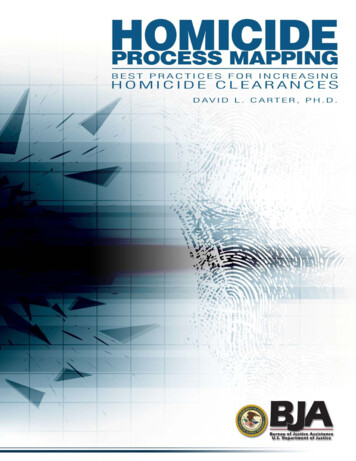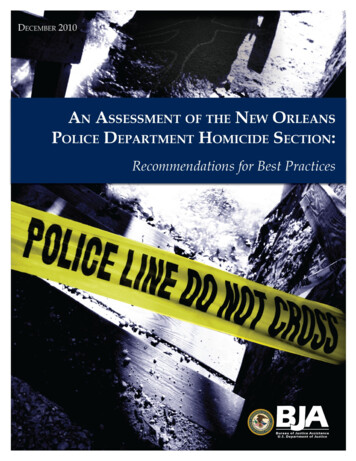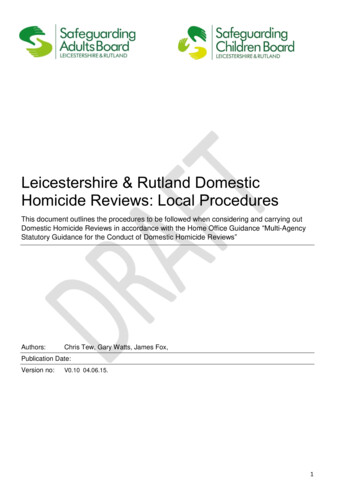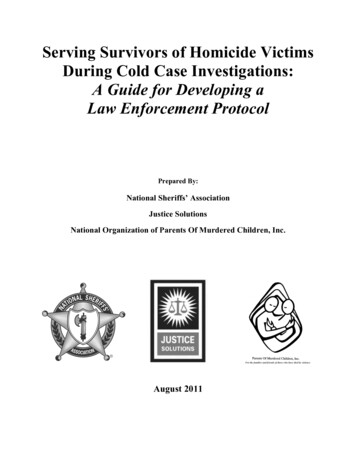
Transcription
Serving Survivors of Homicide VictimsDuring Cold Case Investigations:A Guide for Developing aLaw Enforcement ProtocolPrepared By:National Sheriffs’ AssociationJustice SolutionsNational Organization of Parents Of Murdered Children, Inc.August 2011
With Support From:Office for Victims of CrimeOffice of Justice Programs, U.S. Department of JusticeThis document was produced by the National Sheriffs’ Association under Grant No. 2009-SZ-B9-K009 awarded by the Officefor Victims of Crime, Office of Justice Programs, U.S. Department of Justice under the American Recovery and ReinvestmentAct of 2009. The opinions, findings, and conclusions or recommendations expressed in this document are those of the authorsand do not necessarily represent the official position or policies of the U.S. Department of Justice.
Table of ContentsACKNOWLEDGEMENTS . iiiINTRODUCTION .11.01.11.21.3DEFINITIONS AND TERMINOLOGY .4Defining “Cold Case” .4Determining Which Cases To Pursue .6Terminology Issues .72.02.12.22.3STAFFING OF COLD CASE UNITS .8Staffing Levels and Experience .8Using Volunteer Retired Investigators.8Issues for Rural Agencies .93.03.13.23.33.43.53.63.7INVESTIGATIVE STRATEGIES .9Annually Review All Unsolved Homicide Cases .10Submit Evidence to the CODIS DNA Database .10Maintain Communication With Survivors .11Create and Maintain a Cold Case Register .12Consider Using Homicide Cold Case Playing Cards.12Consider Using Academic Institutions and TARGET Forensic Services .13Understand that Survivors May Look to Others for Assistance in the Investigation .144.04.14.24.3TRAINING AND EDUCATION .15Training for Investigators .16Training for Victim Service Providers .17Education for Survivors of Homicide Victims .195.05.15.25.35.4COMMUNICATING WITH SURVIVORS .20Locating Survivors .21Maintaining Communication .21Providing Services and Referrals .25Transitioning Cases.276.06.16.26.36.46.56.66.76.8COLLABORATING WITH OTHER ENTITIES .27Mental Health Services .28System-Based Victim Services .29Community-Based Victim Services .30Survivors’ Groups .30Victim Advocacy Organizations .31State Crime Victim Compensation Programs .31Domestic Violence Fatality Review Teams .32Threat Assessment Teams.33i
CONCLUSION33APPENDICESAppendix A. Application for Cold Case Review.36Appendix B. Cold Case Solvability Questionnaire.43Appendix C. Cold Case Homicide Investigation: Grief Issues and Survivor Impact .44Appendix D. Sample Cold Case Contact Letter to Survivors .46Appendix E. Sample Cold Case Annual Notification Form .47Appendix F. Victims and the Media .48ii
ACKNOWLEDGEMENTSThe National Sheriffs’ Association, Justice Solutions, and the National Organization of ParentsOf Murdered Children, Inc., thank the Office for Victims of Crime (OVC), Office of JusticePrograms, U.S. Department of Justice for funding this project. The project team also wishes toexpress its appreciation to Mary Atlas-Terry of OVC for her thoughtful and thorough review ofand input on this guide and to Meg Morrow of OVC for her helpful counsel and monitoring ofthis grant project, and for her good nature. Finally, for generously giving of their expertise andtime, the individuals who served on the Project Advisory Group are hereby recognized inacknowledgement of and gratitude for their invaluable contributions to the creation of this guide.Advisory Group MembersSarah Chaikin, Program CoordinatorVictim Assistance UnitDenver, CO, Police DepartmentAllison Murphy, Victim ServiceCoordinatorCharles County, MD, Sheriff’s OfficeCarroll Ann Ellis, Director (retired)Victim Services SectionFairfax County, VA, Police DepartmentMarcia Romano, Administrative ManagerPinal County, AZ, Sheriff’s OfficeRonald Timm, LieutenantCleveland, OH, Division of PoliceJeff Ebersole, CaptainLoudoun County, VA, Sheriff’s OfficeProject StaffTim Woods, DirectorResearch, Development & Grants DivisionNational Sheriffs’ AssociationAlexandria, VATyria Fields, ManagerVictim Services BranchMetropolitan Police DepartmentWashington, DCChristopher Flanagan, DetectiveFairfax County, VA, Police DepartmentDavid Beatty, Executive DirectorDiane Alexander, Senior AdvisorTrudy Gregorie, Senior AdvisorKerry Naughton, Project SpecialistJustice SolutionsWashington, DCTod Goodyear, LieutenantBrevard County, FL, Sheriff’s OfficeKevin Keelan, Detective CorporalCharles County, MD, Sheriff’s OfficeDan Levey, PresidentNational Organization of Parents OfMurdered Children, Inc.Cincinnati, OHSheryl McCollum, DirectorCold Case Investigative Research InstituteBauder CollegeAtlanta, GAOffice for Victims of CrimeMeg Morrow, Attorney AdvisorMary Atlas-Terry, Victim Justice SpecialistWashington, DCiii
INTRODUCTIONStatement of the ProblemAdvancements in DNA technology and other forensic investigative tools have enabled lawenforcement agencies to reopen cases left dormant for years. Although the number of cold casesinvestigated by agencies on a nationwide basis each year is currently not tracked, the FederalBureau of Investigation (FBI) does track the number of offenses cleared. In 2009, 66.6 percent ofthe 13,242 murder and non-negligent manslaughter crimes in the United States were cleared byarrest or exceptional means.1 While this is a significant clearance rate, it leaves many homicidesunsolved each year.In response to the advances in forensic technology, many law enforcement agencies haveestablished cold case units with the hope that reexamining evidence will help solve more crimes.As cases are reopened, investigators are contacting survivors of homicide victims. Althoughsurvivors may be grateful that their loved one’s murder has renewed attention, the reopening of acase can sometimes have traumatic effects. As discussed in Section 4.1, “Training forInvestigators,” survivors may experience a resurgence of grief upon learning that their lovedone’s case has been reactivated. New activity in their case may give survivors hope that it will besolved. However, if this new activity does not move the case forward, then survivors mayreexperience the frustration and grief they experienced when the homicide first occurred. ANational Institute of Justice (NIJ) report2 emphasizes that “reinvestigating a case may causerenewed psychological trauma to the victim and victim’s family.” Moreover, “it should not beassumed that victims and witnesses, even if they were eager to pursue the case when it occurred,are still interested in pursuing the case.” Finally, the NIJ report recommends that officersreinvestigating a case “enlist the aid of victim service providers.” Working in partnership withvictim service providers will help investigators better understand and address the needs ofsurvivors.In addition to the establishment of cold case units by law enforcement agencies, services forsurvivors of homicide victims have also been legislated by two states as well as implementedwithin some federal agencies. In Arizona, “a law enforcement agency that has a cold case shallestablish and maintain a cold case register.”3 In Colorado, there are statutes defining a cold caseand creating a cold case homicide team within the Colorado Bureau of Investigation.4 On the1Federal Bureau of Investigation (September 2010). Crime in the United States 2009. Washington, DC: U.S.Department of Justice, Federal Bureau of Investigation, Criminal Justice Information Services Division. RetrievedFebruary 1, 2011, from www2.fbi.gov/ucr/cius2009/data/table 25.html. “Exceptional means” may include, but isnot limited to, death of the offender; victim’s refusal to cooperate with the prosecution after the offender has beenidentified; or denial of extradition because the offender committed a crime in another jurisdiction and is beingprosecuted for that offense.2National Institute of Justice (July 2002). Using DNA to Solve Cold Cases. Special Report. Washington, DC: U.S.Department of Justice, Office of Justice Programs, National Institute of Justice. NCJ 194197. Retrieved February 1,2011, from www.ncjrs.gov/pdffiles1/nij/194197.pdf.3Ariz. Rev. Stat. § 13-4271(A). Cold case register; law enforcement agencies; definition.4Colo. Rev. Stat. § 24-4.1-302(1.2). Definition of cold case; Colo. Rev. Stat. § 24-33.5-425. Cold case homicideteam.1
federal level, both the Naval Criminal Investigative Service/U.S. Department of the Navy and theFBI have developed protocols to address the needs of survivors in cold case homicides.Response to the ProblemThe National Sheriffs’ Association, Justice Solutions, and the National Organization of ParentsOf Murdered Children, Inc., partnered to create this guide for developing a protocol on how lawenforcement can best serve survivors of homicide victims during cold case investigations. At theoutset, project staff (1) conducted a literature review on the topic of homicide cold cases, and (2)surveyed law enforcement agencies for information on existing cold case units.Literature ReviewTwo reports from the project’s literature review especially underscored the need for this guideand the issues that law enforcement officers, victim service providers, and survivors of homicidevictims face in cold case investigations.First, the Arizona Cold Case Task Force’s A Report to the Governor and the Arizona StateLegislature5 notes the state’s legislated creation of the task force and its responsibilities to (a)“review procedures used by law enforcement agencies in investigating and preserving cold casehomicides;” (b) “review procedures used by law enforcement agencies in investigating recenthomicides;” and (c) “receive comments from members of victim’s families and members of thepublic.” When the task force surveyed all police departments, county sheriff’s offices, and tribalpolice departments in Arizona, only 9.4 percent of responding agencies reported having writtenprotocols for the handling of cold case homicides. The Conclusion by the Best PracticesSubcommittee of the Task Force “recommends that every Arizona law enforcement agency witha cold case homicide have a written cold case homicide protocol” and states that “cold casehomicides are one of the most significant challenges facing law enforcement agencies nationwide.”Second, Developing a Strategy to Provide Services and Support Victims of Unsolved, SeriousCrimes, Final Report,6 by the Canadian Resource Centre for Victims of Crime (CRCVC), is acompilation of data from the CRCVC’s survey questionnaires and roundtable meetings on the“needs of victims in unsolved crime” (including homicide, sexual assault, and missing personcases) and the “existing services for this population.” Data from the three, detailedquestionnaires—one for law enforcement investigators, one for victim service providers, and onefor victims and their families—were analyzed, as were the discussions from the two, 2-dayroundtable meetings: one for law enforcement officers and victim service providers, and one forsurvivors of homicide victims. The report lists 25 policy recommendations (some of which are5Cold Case Task Force (December 28, 2007). A Report to the Governor and the Arizona State Legislature, Phoenix,AZ: Office of the Attorney General. Retrieved February 2, 2011, fromwww.azag.gov/law ian Resource Centre for Victims of Crime (August 30, 2005). Developing a Strategy to Provide Services andSupport Victims of Unsolved, Serious Crimes, Final Report. Ottawa, ON: Canadian Resource Centre for Victims ofCrime. Retrieved February 2, 2011, from www.crcvc.ca/docs/Unsolved crimes finalreport.pdf.2
referenced throughout this guide) under the headings of law enforcement, victim needs, andfuture research. One of those recommendations for cases of unsolved, serious crime is that “lawenforcement services should develop protocols.”Survey of Law Enforcement AgenciesProject staff also developed a questionnaire, “Serving Survivors of Homicide Victims DuringCold Case Investigations: A Survey to Identify Existing Cold Case Units,” and disseminated itvia e-mail to all 3,083 sheriff’s offices across the United States and to all state sheriffs’associations. It was also posted on the International Association of Chiefs of Police’s Web siteand announced on a victim service provider listserv. The survey asked 12 questions related to thefollowing:1. Where the respondent’s cold case unit is located within the law enforcement agency’sdepartments.2. When it was established.3. How the unit defines “cold case.”4. Staffing level of the unit.5. Background/experience of staff.6. Types of crime investigated.7. Number of cases investigated.8. Number of cases closed and their disposition.9. Types of services offered to survivors.10. If the unit has policies and procedures.11. If those policies and procedures address services to survivors.12. Challenges staff face in working with survivors.Eighty-two surveys were completed, with only 31 respondents (38 percent) indicating that theyhave a separate cold case unit within their agencies. Twenty of these 31 respondents reportedhaving policies and procedures specific to cold case investigations; and of those 20 respondents,17 have policies and procedures specifically addressing survivors.SummaryThe findings from the project’s literature review and the data from the survey substantiated theneed for this guide to assist every law enforcement agency, regardless of whether it has aseparate cold case unit, in the development of a protocol on serving survivors of homicidevictims during cold case investigations.7 Accordingly, this guide provides a framework for thedevelopment of an agency protocol to more effectively work with and, moreover, better servesurvivors of homicide victims.7See Section 1.3, “Terminology Issues,” for information on the use of the term “cold” case.3
Serving Survivors of Homicide Victims During Cold Case Investigations:A Guide for Developing a Law Enforcement Protocol1.0 DEFINITIONS AND TERMINOLOGYEvery law enforcement agency, regardless of the agency’s size, should have a written,agency-specific, cold case homicide protocol. The first step in developing this protocol is toestablish the criteria that define a case as “cold.”Currently, there is no uniform definition of “cold case homicide,” neither nationally, betweenstates, nor even within a state, with the exception of a very few states (including Arizona andColorado) that have developed or legislated a statewide definition. Furthermore, becausethere is no statute of limitations on the crime of homicide, an investigation is never closeduntil cleared by arrest or another criterion that has been agreed on or set by law or policywithin a jurisdiction or law enforcement agency. Every unsolved homicide investigation,however, eventually arrives at a point where there is no further lead or evidence to activelypursue. With few exceptions, law enforcement agencies have only minimal or vagueguidelines and policies on the set of circumstances, or the length of “tolled” time, that causesan active homicide investigation to become inactive or cold. This lack of criteria defining acold case poses a problem for law enforcement in communicating with surviving familymembers of homicide victims and creates confusion and frustration among the survivors.Thus, law enforcement agencies should begin their development of a cold case protocol byfirst defining clearly the criteria that transition an active homicide investigation to inactive orcold status. Only then can the second, critical step in developing a protocol be tackled:defining the criteria that determine which cold cases are pursued.1.1DEFINING “COLD CASE”A. Two General Categories of DefinitionAlthough most law enforcement agencies’ definitions of cold case homicides can beclassified into two general categories, either “leads” dependent or “time” dependent (seeSection 1.1C, below), the variety of definitions used by agencies makes it difficult tograsp the scope or all the issues of the cold case homicide problem.B. Clear and Consistent DefinitionA clear and consistent definition of a cold case homicide will—1. Foster a common understanding of the issues surrounding cold case homicides.2. Make it possible to track homicide cases through the investigatory process.3. Facilitate the exact identification of investigatory responsibility at any given time.The flip side of this clear and consistent definition between “homicide” and “cold casehomicide” case is that the latter term may imply to survivors that investigatoryresponsibility for the homicide has shifted; which may, indeed, be the case. Survivors,however, may be left with the impression that their case will no longer be investigated atall, by anyone. For this reason, developing the agency’s definition of a cold casehomicide should be carefully thought out and clearly communicated to all agencypersonnel and survivors of homicide victims.4
Furthermore, it is important to recognize that homicide investigators can be passionateabout solving cases that originate under their watch. The transition of investigatoryresponsibility to a cold case unit can cause interruptions in lines of communication and intrust that have been nurtured over time by the original homicide investigator with avictim’s surviving family. Accordingly, a cold case homicide protocol should both honorthe commitment of homicide investigators and be sensitive to the needs of the victim’ssurvivors.C. Statutory and “Working” Definitions of Cold CaseIn some jurisdictions, the definition of a cold case is legislated; in other jurisdictions,agencies will need to formulate a working definition.1. Arizona Revised Statute, § 13-4271(F): “Cold case” means a homicide or felonysexual offense that remains unsolved for 1 year or more after being reported to a lawenforcement agency and that has no viable and unexplored investigative leads.2. Colorado Revised Statute, § 24-4.1-302(1.2): “Cold case” means a felony crimereported to law enforcement that has remained unsolved for over 1 year after thecrime was initially reported to law enforcement and for which the applicable statuteof limitations has not expired.3. Sample local and federal law enforcement agency definitions of “cold case,” some ofwhich have no timeframe, include:a. Any major violent crime wherein all leads have been exhausted and allvictims/witnesses have been interviewed with any suspects being excluded(Flagler County Sheriff’s Office, Bunnell, Florida).b. Any case that has not generated a lead within 6 months and has not passed thestatute of limitations (Jerome County Sheriff’s Office, Jerome, Idaho).c. Any unsolved major felony that has become “stagnant” for 1 year (BelmontCounty Sheriff’s Office, St. Clairsville, Ohio).d. Any homicide, suspicious death, unidentified human remains, and missing personcases (under suspicious circumstances) that have gone unresolved due to a lack ofleads or case activity for 2 years or more (Volusia County Sheriff’s Office,Daytona Beach, Florida).e. Any unsolved murder after the third anniversary (Metropolitan PoliceDepartment, Washington, D.C.).f. Any unsolved homicide case after 3 years if all leads have been exhausted, andany murder case where evidence was not tested for DNA (Houston PoliceDepartment, Houston, Texas).g. A homicide that has remained unsolved for more than 3 years or a homicide casein which the original detective assigned as the case manager or the secondarydetective involved has been transferred out of the Criminal Investigations Unit(Tulsa County Sheriff’s Office, Tulsa, Oklahoma).h. Any unresolved or pending cases; this occurs when all leads have been thoroughlyinvestigated and no viable suspects have been identified (Federal Bureau ofInvestigation).i. A death case wherein the manner of death has been ruled homicide or undeterminedand all logical investigative leads have been exhausted without resolution (NavalCriminal Investigative Service).5
1.2DETERMINING WHICH CASES TO PURSUEAfter establishing the criteria that define a case as cold, law enforcement agencies shouldthen define the criteria that determine which cold cases are pursued. Identifying and selectingcases to be worked involves more than merely picking back up on unsolved cases. Thefollowing checklist can help investigators as they begin the process of determining whichcases to reopen:1. Review cold cases in the record/archive files.2. Seek information on cases from investigators previously assigned to the homicideunit.3. Seek information on cases from officers in other departments of the agency.4. Review investigators’ information requests of family members and acquaintances ofthe victims.5. Seek information from other law enforcement agencies that had some connectionwith the cases or the parties in the cases.6. See Appendix A, “Application for Cold Case Review.”A. Cold Case Solvability QuestionnaireA solvability questionnaire can also assist investigators in determining which cases topursue. See Appendix B for a sample questionnaire to be completed by investigators,crime lab specialists, and prosecutors.1. Most cold case units identify their strongest solvability factor as the experience of theinvestigators. Over time, circumstances related to the case may change, and almost allcases can benefit from a “fresh set of eyes” examining the files and evidence.In addition, survivors of homicide victims may initiate their own investigations.Agency investigators should be open and react positively to information or evidenceobtained by survivors.2. After completing and reviewing solvability questionnaires, an investigator shouldfocus on only one or two cases at a time to increase the likelihood of closing a case.B. Cold Case Prioritization/Triage Rating ScaleThe Arizona Cold Case Task Force recommends in its 2007 report to the governor andstate legislature that all cold case homicide protocols, regardless of agency size, include“the annual review and prioritization [triage] of all cold case homicides.”8 An agency willneed to determine for itself, however, based on its resources, what constitutes a practicaltimeframe for cold case review, prioritization/triage, and contact with survivors. Someagencies may even have the resources for semi-annual or quarterly reviews. In any event,during these reviews, investigators should categorize all leads and, even if there are noleads, still call survivors and share that information.1. A periodic review of all cold cases using a standard cold case solvabilityquestionnaire fosters the allocation of resources to those cases where newinformational details or new investigatory practices and technologies have increasedthe chances that a case can be solved. In Pima County, Arizona, the Cold CaseHomicide Task Force uses this strategic approach to cold case review and caseprioritization/triage via a round table discussion. Ranking all existing cold casehomicides based on their solvability allows the task force to focus its resources and8Cold Case Task Force, supra note 5.6
expertise on previously unsolved cases where new evidence and leads have emerged.2. The Cold Case/Violent Criminal Apprehension Program Unit of the Colorado Bureauof Investigation uses the following “At-a-Glance” chart9 to prioritize cases:HighKnown suspect, preserved physical evidence, witnesses availableModerateNo known suspect but physical evidence preserved, witnesses availableNo known suspect, insufficient evidence, witnesses availableLowNo known suspects, physical evidence, or material witnessesIn short, periodic reviews and prioritization/triage of unsolved homicide cases address thefact that the dynamics of cases change over time and new investigatory technologies aredeveloped, both of which can create new leads and add new information to aninvestigation.1.3TERMINOLOGY ISSUESTerminology is an issue that requires thoughtful review in the development of a cold caseprotocol.A. Survivors of homicide victims may have concerns with words like “prioritization ratingscale,” as this may seem to imply a value judgment has been made about their case.Terms like “triage scale” may minimize such implications.B. The word “cold,” as in “cold cases” and “cold case unit,” is established terminology inthe law enforcement field, although other terminology, like “slow to resolve cases” or“historical homicides,”10 does infrequently appear in the academic literature. Lawenforcement officials should be sensitive in their use of the potentially painful word“cold” and may want to consider explaining to survivors why specific language is used.C. A publication style sheet at the International Association of Chiefs of Police even states:“It is the editorial policy of Police Chief magazine not to use the term cold case(s) whenreferring to Open-Unsolved investigations. This term has been made popular by theentertainment industry and the news media, but it does not properly reflect theprofessional law enforcement view of open-unsolved investigations. Families, friends,neighbors, and the police officers who have investigated these cases have not forgottenthe victims and crimes committed, and law enforcement agencies continuously seek tosolve all cases.”D. Terms like “open,” “closed,” “active,” and “inactive,” if there are no clear agencydefinitions and explanations, will confuse and frustrate survivors about their cases andlaw enforcement procedures.9Colorado Bureau of Investigation. (2010). Cold Case Investigations—Strategies and Best Practices TrainingCurriculum. Note: Training course developed by the Cold Case Task Force (HB1272) Curriculum Committee, withsupport from the Arapahoe County, CO, Sheriff’s Office and the Colorado Department of Public Safety.10Canadian Resource Centre for Victims of Crime, supra note 6.7
2.0STAFFING OF COLD CASE UNITSOne of the many challenges in establishing and maintaining a cold case unit is determininghow to staff the unit. Decisions must be made about the number of investigators assigned tothe unit and the level of experience needed to take on these difficult cases. In the NationalSheriffs’ Association’s (NSA) survey questionnaire referenced in the “Introduction,”respondents were asked to provide information about the level of experience and number ofinvestigators assigned to work cold cases in their law enforcement agencies. Of the 31respondent agencies that have a separate cold case unit within their agency, 22 reportedhaving one to three investigators assigned to the unit, five agencies reported four to sixinvestigators, and four agencies reported seven to 10 investigators. Eighteen respondentsindicated that at least one of the investigators in their agency’s cold case unit has more than20 years of experience, eight have at least one investigator with 10–20 years of experi
and creating a cold case homicide team within the Colorado Bureau of Investigation.4 On the 1 Federal Bureau of Investigation (September 2010). Crime in the United States 2009. Washington, DC: U.S. Department of Justice, Federal Bureau of Investigation, Criminal Justice Information Services Division. Retrieved
